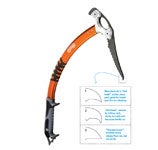Look Sharp

"Bird-Beak-Ice-Axe"
In ice climbing, as in life, being dull isn’t cool. A dull edge, whether a crampon point or an ice tool pick, takes more effort to drive into the ice. Blunt tools also feel considerably less secure and shatter more ice, sending debris down upon your belayer. If you find your climbing plagued by these traits, it could be time to sharpen your points or pony up for new gear. Either way, tools and crampons—and subsequently your ice climbing—can benefit from some tuning.
Ice Axe

Modifying ice picks becomes a necessity as tools become dull from constant use and the occasional whack against unseen rock beneath the ice. You can improve a pick’s characteristics with just a few strokes of a file. If you have a manufactured “bird beak” on your tool, it will climb thin ice and mixed terrain well, but may be “sticky” if you over-drive it into fat ice. A stuck pick on a steep pillar is never fun—you can wear yourself out trying to dislodge your tool. Bird beaks can be gently filed off to give a tool an easy release from the ice. A “standard point” on your pick will climb fat ice well and release easily, but may not be sticky enough for thin and mixed climbing, where you’ll be tapping for precision rather than swinging.
If you’re shopping around for new ice gear, the best place to make a decision is at an ice climbing festival, where companies bring demo fleets of tools and crampons for attendees to use. There are also numerous gear shops that have rental tools. Ask yourself the following questions: How comfortable is the tool to hold? Is the handle too big or small for your gloved hands? How many times do you have to swing before you felt comfortable getting a good stick in the ice? If there’s no ice fest or gear shop with rentals near you, check out ice-centric forums like neice.com for experienced climbers’ opinions and suggestions.
Crampons
Crampon points usually come out of the box nice and sharp, and they are configured in one of two ways: dual- or monopoint. (Some crampons can be configured both ways.) Ask yourself what kind of ice climbing you’ll be doing most to determine which setup you’ll need.
Dual-points are better for soft, warmer ice conditions, when the solid purchase afforded by two points offers more security. Choose dualpoints for climbing mixed snow and ice faces, or for big, fat ice in the Canadian Rockies on warm, earlyspring days. Dual-points are also better for rotten, unconsolidated ice. But temperature and stability aren’t the only factor in choosing the set-up. For example, Nepal has relatively warm winters, but it’s a very dry environment, and some ice routes can be incredibly brittle because the moisture has evaporated from the ice; mono-points would be best on those routes. A sharp pair of mono-points will allow you to place your feet more precisely, with less kicking, and without excessively fracturing the ice. They’re usually the best call for climbing in the Northeast on a cold day, or while mixed climbing, when you’ll need to delicately and accurately put a point on the rock.
Many mono-point crampons are modular— they come with the ability to set up the point in the middle or offset, meaning the point is more toward your big toe. Most folks prefer to rig the point in offset mode, which places the point under the strongest part of the foot and helps you kick it straight into the ice more naturally.
Sharpening Tips
Keeping your tools and crampons sharp is important to maintain the equipment’s high performance. Use a mill bastard file—and take it slow. Take off as little metal as possible, and try to maintain the original shape of the picks and crampon points. As you’re sharpening, keep in mind that you’re also shortening the pick and points, which can degrade their functionality and shorten their lifespan if overdone. Consider wearing a pair of gloves when handling tools and crampons so you don’t injure yourself on the sharp points. Most of the time, you’ll need only to sharpen the front and secondary points of crampons. However, it’s worth the effort to tune up the bottom points a couple of times a season so you don’t slip while flat-footing low-angled ice or stemming between columns.
Ian Osteyee is owner of Adirondack Mountain Guides in New York, and an athlete for CAMP and BlueWater ropes.
For instructions on sharpening your crampons, visit climbing.com/video/how-to-sharpen-crampons.